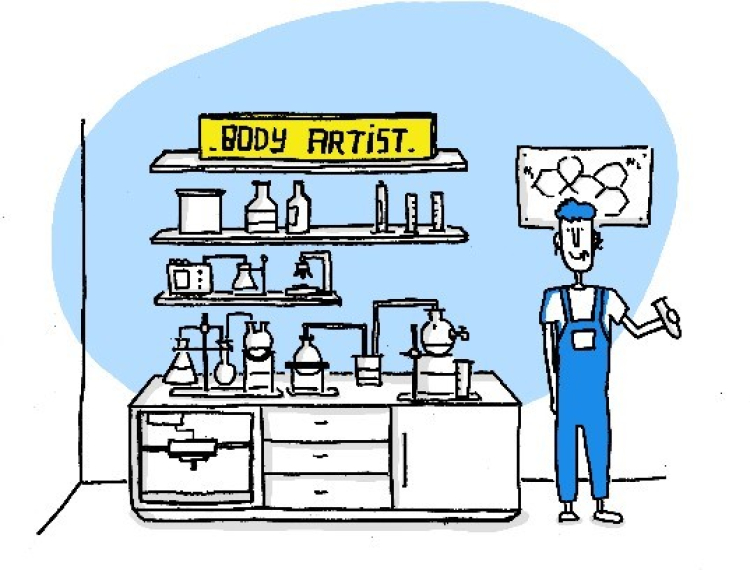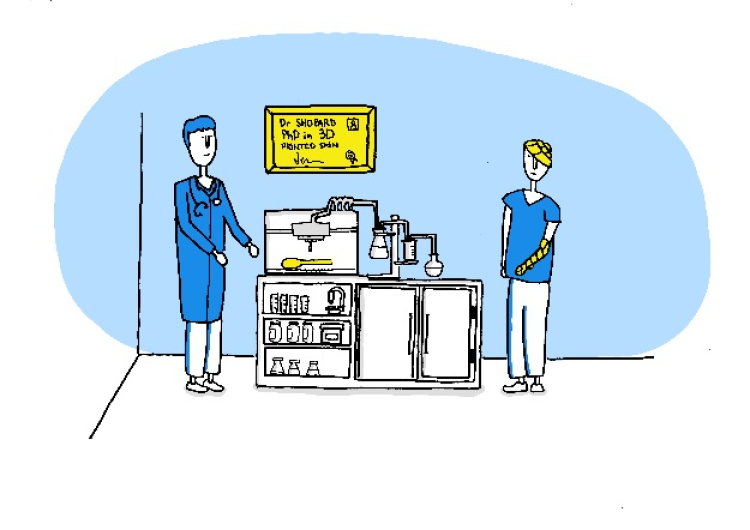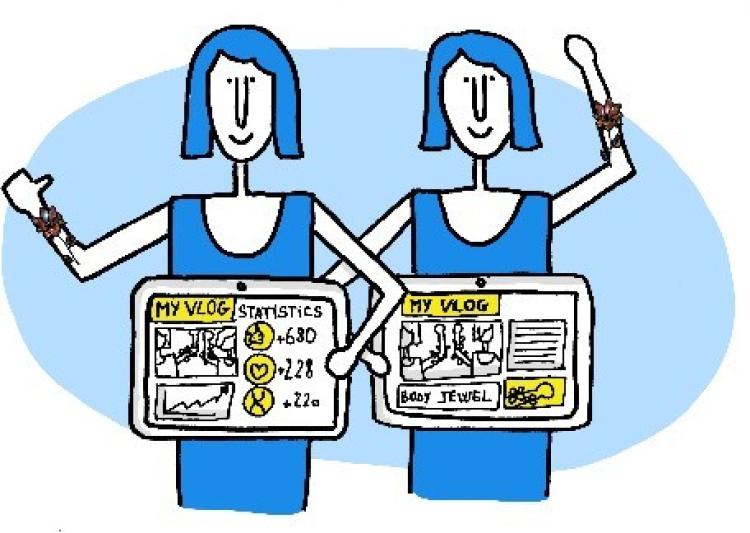Toekomstscenario: doe-het-zelf tattoos
Het is onmogelijk exact te voorspellen hoe 3D-bioprinten zich zal ontwikkelen. De discussie over mogelijke impact van een technologie kunnen we wel al voeren. Een manier om dat te doen, is aan de hand van een fictief scenario - een 'techno-moral vignette'. In dit scenario gaan doe-het-zelvers aan de slag met 3D-bioprinten.

Onderstaand fictief scenario is geen voorspelling voor de toekomst, maar een manier om de discussie te voeren over mogelijke kansen en risico's van de ontwikkeling van 3D-bioprinten.
Dit scenario ontwikkelde het Rathenau Instituut voor het Engelstalige rapport 'Additive biomanufacturing' en is niet vertaald.
What happens when body artists cultivate cells in a lab?
In this scenario, twins Rubi and Sai, 18-year-old vloggers from Denmark, travel to a DIY studio in Berlin to get a colourful body jewel (“I’ll take a tiny sample of your cells and then we’ll do everything here in the lab”).
“Wow! I really want that,” Rubi said to her brother Sai. “Do you see what they have on their arms? That’s what I want for us too!” She pointed to something glittering on the arms of the famous twins that they were named after, Rubi and Sai Cole, the children of the singers Bella May and JilZ.

Rubi pointed excitedly to an audio-visual projection of the other Rubi and Sai, who were proudly displaying what appeared to be a new kind of tattoo. Both had a small flower on the inside of their lower arm, Rubi on her right arm and Sai on his left. The flower was colourful, but it couldn’t possibly be made of the usual tattoo ink. Rubi immediately recognised them as body jewels, 3D tattoos made from the wearer’s own skin cells. Cultivated in the refined lab environment of a body art artist, the cluster of cells were transformed into a beautiful three-dimensional flower with colours and glittery reflections that were impossible to make with plain old tattoo ink.
Sai was intrigued. Rubi had shown him some photographs of people with body jewels. Now that he saw the other Rubi and Sai sporting body jewels, he thought it would be amazing to have them too. All their online friends would love it. Body jewels were new and edgy and only a few people had them. It would be a fabulous opportunity for their vlog, he thought. They would hit a million viewers for sure, and showing that body jewels were not only for the rich and famous but affordable for normal teenagers would attract a great sponsor.
A new generation of tattoos
Rubi had always followed body art trends. Their parents had tattoos all over their arms and they were still very happy with them. For as long as she could remember, Rubi felt proud of the strong presence that their tattooed bodies projected. Now she could have something even better.
The technology was originally developed to treat burn victims. Skin replacement methods became better and better. Researchers also used skin and other cells to run tests without using laboratory animals. It was even possible to print deeper layers of tissue, with nerves and blood vessels. Artists had started using the technology outside the lab to create body art that could not be made in any other way. As far as Rubi was aware, there were only a few artists doing this. They had formed a small, global DIY community that shared designs, experiments, results and failures.

Medi Valley was where it had all started, not in the official medical facilities but in ”artist-owned” labs at the edges of the valley. It was too expensive for them to travel there all the way from Denmark. Local consultants would do the intake, but they would still have to fly to Baltimore for the actual procedure. The cost varied from one place to the next, and you could easily end up in a lab with a dubious reputation.
She knew that some body artists in Europe had adopted the new technology and now designed body jewels themselves and experimented in DIY labs with colours, artistic effects and new forms. One of them was in Berlin, where she hoped they could both get an experimental jewel for next to nothing. The studio she’d heard of was part of the underground art scene, but she’d read some great reviews about the artists behind it. They had refined their skills by practising on their own bodies. Karsten, the studio’s founder, used to work in a public research lab, but he had wanted to go further and was now probing the limits of legislation.
“Nothing more than a mild, local anaesthetic”

A few weeks later, the twins found themselves at a location just outside Neukölln. Rubi took it all in. The studio, or lab if you want, had all sorts of boxes on shelves with tubes going in and out. Karsten, a tall guy with at least twenty rings pierced through his lips, was taken by Rubi’s enthusiasm. He liked the young duo. “It’s nothing more than a mild, local anaesthetic,” he said. “I’ll take a tiny sample of your cells and then we’ll do everything here in the lab.” He gestured enthusiastically as he talked about the flower that he wanted to create for Rubi and Sai. He showed them his own jewel, just above his waistline.
“You see, it’s nothing like a normal tattoo. It has layers and the colours are much more intense.”
The four months needed to prepare the jewels seemed endless to Rubi. The skin cells first had to be modified and multiplied before they could be printed in the shape they had designed with Karsten’s help. Sai was also a little nervous. The famous Rubi and Sai had attracted quite a lot of attention with their body jewels. And there were people with similar jewels all over the internet now. Would they be in time to inspire their online friends and attract more followers to their vlog?
Finally, Rubi and Sai returned to Berlin. Karsten would attach the jewel to the skin with some sort of bio-glue. When he showed the twins the two jewels, they could not believe their eyes. They looked even better than the three-dimensional figure on Karsten’s body. “I’ve applied a new technique to let the green come out even better,” Karsten tells them proudly. When the twins walked out of the studio, their arms were still covered in bandages. “You need to protect it for at least a week,” Karsten told them, but they could hardly wait to show their mum and dad.
Back at home, dad was more excited than Rubi and Sai had expected, but also a little concerned. Under the bandages, the body jewels did not look as incredible as Rubi claimed. Dad found them a little weird, almost like a fibroma. But Rubi wouldn’t listen. A few days later, she revealed the body jewels on their vlog. Just as they had predicted, the views poured in. “Over 10,000 views within an hour.” Karsten would like that too and gain some customers in return for his help. Sai was also delighted. The views and the likes gave them a lot of data about their viewers that he could easily sell for a lot of money.
Horrible infections
Dad’s concern was not unfounded. He had seen pictures of horrible infections on the internet. But that wasn’t even the worst of it. Some online articles suggested that these jewels could develop into cancer, with cells dividing and migrating. Or the material might travel to other parts of the body where it could do damage. “Would it be possible to remove the jewel?” he wondered.
The National Health Inspectorate had launched a debate about body jewels even before the EU could ask for expert advice on regulatory restrictions. Without robust knowledge about the long-term effects, the NHI was already advising against using these techniques in DIY studios. It emphasised that the technology was in its infancy and that the health risks were unclear. One of the questions raised in the public debate was who should pay for medical care if something went wrong. Many people thought that public money shouldn’t be used to treat people who had allowed themselves to be used as guinea pigs. Some wanted to forbid body jewels altogether. Others thought that people had the right to do what they wanted with their own body, and that proper regulation should prevent the use of hazardous materials, inappropriate facilities and high-risk procedures carried out by people without the right medical training. For dad, these were not real issues. He was simply worried about his kids.
“The EU has no say in this”
Mum was also increasingly unhappy about the twins’ body jewels. She followed the debate and read that politicians in Brussels were talking about banning consultants for overseas beauty treatments and punishing underground DIY parlours. Their fear was that criminals would use this technique to copy fingerprints and sell them on the Dark Web. However, legal experts explained that it was extremely difficult for the EU to restrict DIY practices, especially if studios offered their services for free to friends and acquaintances or as part of a barter system. And because authorities in other parts of the world were more lenient about commercialising these technologies for body art purposes, regulation was even more difficult.
The more mum heard, the angrier she got. Health and safety had not been a priority in this field, much less so than in the public medical sector. There was no evidence that the procedure was safe – in fact, quite the contrary. Body jewels might have been a Medi Valley spin-off, but what the colouring and layering would do to the property and safety of the printed skin had never been clinically tested. “If this is true, I want yours to be removed immediately,” she screamed at Rubi and Sai.
Rubi tried to calm her down: “Don’t worry, mum. The studio also does all sorts of regular implants that track your health and that kind of thing. These have been available for years now and people like Karsten know what they’re doing in their studio.” But mum was not convinced. She continued to worry about the risks. The National Health Inspectorate must have good reasons to be cautious about body jewels.

This scenario adresses possible future developments such as:
- rapid progress of research and development in life sciences in the EU; - dissemination of research and development for cosmetic purposes; - restrictive regulation of bio-AM; - individualisation and autonomy for citizens; - privatisation of healthcare services and former government support; - “Attention is everything”; - strong presence of the DIY community, but lack of control and regulation by state or EU;Illustraties met dank aan le Laboratoire d'Usages Collaboratifs.